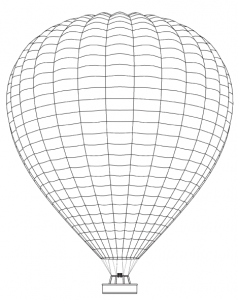 Most hot air balloons are designed using a shape which minimises the stress on the fabric. We provide a balloon design spreadsheet which allows you to design a pattern for a natural shaped balloon of a given volume.
Most hot air balloons are designed using a shape which minimises the stress on the fabric. We provide a balloon design spreadsheet which allows you to design a pattern for a natural shaped balloon of a given volume.
History
In the early days of upper atmosphere research using helium balloons it was common for the balloons to burst when they neared their intended float altitude. These balloon design failures were traced to the shape of the balloons loading the thin polyethylene material until it ruptured. The US military commissioned a company called General Mills to devise a balloon design which minimised the fabric stress. Justin Smalley who headed the team devised a series of ‘Sigma Tables’ which determine the optimum shape of a balloon for a given material weight, load, and air density. For hot air balloons which are generally used in the lower levels of the atmosphere the optimum shape is based on Smalley’s Sigma Zero table.
Download
Download the balloon design spreadsheet
Technical data content credited to Mr Steve Griffin
